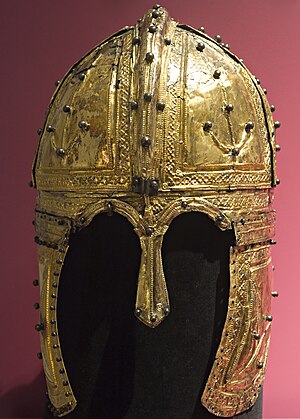Deurne helmet
| Deurne helmet | |
|---|---|

|
|
| Information | |
| Weapon type: | Protective weapon |
| Designations: | Crest helmet |
| Use: | helmet |
| Working time: | Late antiquity |
| Region of origin / author: |
Roman Empire , armourers |
| Distribution: | Roman Empire |
| Lists on the subject | |
The Roman helmet from Deurne , also known as Helenaveen's helmet or Peelhelm , was found in 1910 while cutting peat in the De Peel moor near Deurne in the south of the Netherlands . It is one of the most important archaeological finds from this region. Along with the helmet, there were 37 coins of Emperor Constantine , a spur , a fibula , three shoes from different pairs, a sword scabbard , leather scraps, a purse and some smaller objects. The helmet is now in the Rijksmuseum van Oudheden . In older research, the findings were interpreted to mean that a Roman officer had an accident in the moor and died on site. New investigations see the finds as part of an ancient religious deposit.
The helmet is a late Roman crested helmet that was originally made of iron with a gold-plated silver sheet covering . When the helmet was found, the iron was completely gone. The iron core, which was no longer present, consisted of two shells with a leather lining. The shells were held together by a crest and a headband. The headband also has a nose protector. Two cheek flaps and a neck guard were attached to the headband with leather cords. Gilded decorative panels were attached to the helmet.
On the neck of the helmet is the name M. TITVS LVNAMIS, next to it the weight LIBR IL (1 pound and 1 1 ⁄ 2 ounces = 368.382 g.). On the right side of the headband there is the inscription STABLESIA VI. According to this inscription, the owner of the helmet, an officer, belonged to the Vexillatio comitatentis stablesiana VI , a guard troop , which is also mentioned in the Notitia Dignitatum . The name comes either from a blacksmith who applied the silver to the helmet, or from a "verificator" who controlled the amount of silver. The helmet with neck protection and cheek flaps is a typical equestrian helmet of Sassanid origin. Such helmets have been attested in the Roman Empire since around 312 AD, although specimens with a sheet of silver coating were obviously reserved for senior military personnel.
The coins were relatively freshly minted. They date from 311 to 319. This therefore suggests that the landfill took place around 319/320. In the older literature it was assumed that a Roman officer fell into the moor with a horse. The shoes indicated that at least two people tried to save him and lost their shoes in the process. The bodies of the officer and the horse are completely lost in the moor. A new analysis of the finds, however, comes to the conclusion that the helmet and the other objects were ritually deposited.
Web links
- Pim de Klerk: Palaeocological researches of the Roman Helmet of Deurne (Peel Region, SE Netherlands). In: pimdeklerk-palynology.eu. April 8, 2019 (English).
- De Gouden helmet. Nationaal Beiaard- en Natuurmuseum Asten (Dutch, website for the 100th anniversary of the helmet discovery).
- Jim Grondijs: Topvondst: de Romeinse Peelhelm. In: Archeology Online. (Dutch).
Individual evidence
- ↑ Machiel A. Evelein: A Roman helmet of the Leiden Museum. In Prehistoric Journal . Vol. 3, No. 1, 1911, pp. 144-156, doi : 10.1515 / prhz-1911-0108 .
- ↑ a b Mechthild Schulze in: Gallien in der Spätantike. From Emperor Constantine to Childerich, King of the Franks. von Zabern, Mainz 1980, ISBN 3-8053-0485-4 , p. 138.
- ^ Carol van Driel-Murray: A late Roman assemblage from Deurne (Netherlands). In: Bonner yearbooks of the Rheinisches Landesmuseum in Bonn . Vol. 200, 2000, pp. 293-308, especially pp. 305-306, doi : 10.11588 / bjb.2000.0.46370 .